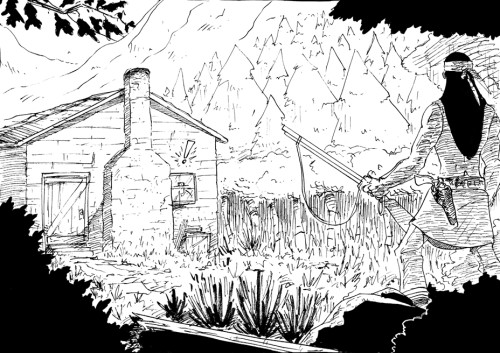Sketch Fridays #07 – Long John Preview
This week’s Sketch Friday––a panel from an upcoming page––serves at least two purposes. First, it’s proof that pages for Long John are being made, albeit slowly. Second, it’s a way to introduce a new character who has, up until this point, been featured only in conversation. Welcome the backside of Jonny Mono.
I’ll explain more about him in future posts, when his character is actually a part of the story. The reason I wanted to share this drawing is that it shows a type of shot that I pepper throughout Long John as the story progresses. Big open establishing shots add to the cinematic quality of the story, plus it really presents a challenge for me as an artist (a challenge I often put off as long as possible). With the opening shot of chapter one, Long John’s saunter into Poverty Flat, the third panel of the second page of chapter 2, I really want to emphasize place in Long John as much as I want to focus on character.
What was one of the most aggravating issues with designing this panel was how to pose Jonny Mono. It’s about really knowing the character before he really has had any time on the page and knowing how he should be feeling before and on this page. Of course, I feel I have a soft concrete understanding of Jonny so far, but even with my staunch stance on the artist controlling the art (and not giving authorship over to “the story,” “the characters,” or “the moment” controlling direction––none of those are real; the author is, and is always in complete control) I submit to the fact that characters change once they get into a story. Drawing them a lot changes them literally on the page and also in my head, which makes the story and character more clear. Mix into that recipe the need for it to look good or––in the parlance of my generation––cool, and suddenly I have a lot to think about for a panel that needs “Long John sees Jonny from inside the cabin a good distance away.”
This actually speaks to an issue that I see a lot of comic artists fall into when they decide to write their own stories. I have been a proponent of artists striking out from the writer/artist paradigm (and hierarchy, in some circles), but with the caveat that artists should study the art of storycraft as much as art (because it’s not that hard, it’s a matter of commitment). Many artists, instead, simply resort to drawing things that “look cool”––the style over substance argument––which, undoubtedly, is cool but does it amount to anything? Does it last? These artists create 150-page graphic novels that can be read in fifteen minutes because it’s padded with really cool-looking action and splash pages.
Luckily, there are many artists that have dynamic styles that also present thoughtful, developed stories. This is important for artists because even if your art on its own is kinetic, dynamic, and cool, working on the story only enhances the art. I am thinking of artists like Kazu Kibuishi and his Amulet series (though I’m partial to his one-shot sci-fi western, Daisy Kutter), Sean Murphy with his Punk Rock Jesus (though his recent work has been with writers as well), Becky Cloonan, and Eric Powell’s The Goon (which, despite its standard chaotic nature, Powell has shown he can craft a solid story). These are artists that love to draw and do so well, but they have––through their own means––also included, as part of their art, the study of narrative. Because of that––especially in the cases of Cloonan and Powell, though exhibit this in completely different ways––they create something wholly unique. It’s not just cool art with no story, and it’s not just good story with rote art. It’s comics narrative, taking advantage of both arts and weaving them together to create something wholly unique to comics themselves.
Part of committing to story as much as art is the willingness to stop and take a breath and let the art speak in its own language, which is why I actually enjoy drawing scenes such as the one above and dropping them throughout the story, as infuriating as it may be to get there.


Discussion ¬